Abstract
Architecture as the making of metaphors is the study of effective design. One of the roles of conceptual metaphor is that it permits the user to form the concept of the virtual world from the aspect of time and the motion in the physical dimension of the architecture world. Utilizing metaphor to distinguish the secret attributes of the content is an indicative factor. The historical surroundings have contained and will contain during the time of natural actions and interventions from the human. One of the most important concerns in the preservation operation is the addition to the historical structures. It is the role of new and modern architecture styles to indicate the importance and architectural significance of historical structures. One of the main concerns in the field of conservation is attributed to the relationship between the historical structures and contemporary modern additions. In most cases, the modern additions influence the primary building to display its mental image to the users. The present research aims to study the metaphoric viewpoints of new additions to historic buildings in the historical context and recognize the appropriate balance between these two concepts. For this aim, two case studies were analyzed with the methodology that considers the metaphoric aspects of the new additions.
PUBLIC INTEREST STATEMENT
Metaphor can be defined as a comparison between two different and unrelated subjects. In architecture, buildings are not only playing with the visual image of the form but it plays with the hidden meaning of it. The main purpose of architecture is to design exclusive architectural environments and create effective architectural identities that extend the thoughts, feelings and imagination of human beings. A design approach based on metaphors gives architects the opportunity to design buildings with familiar meanings, values of society. New buildings in historical environments, particularly the contemporary extensions, are important in the metaphoric approach, and from that point of view they can create a strong mental image in people’s mind. This research aims to study the metaphoric viewpoints of contemporary extensions and its effects to create a mental image. For this aim, two case studies were analysed with the methodology that considers the metaphoric aspects of the new additions.
1. Introduction
Metaphor could be found in all fields such as conservation, work, song, media and even school. The metaphor emerges in many aspects of a structure as the volume, shape, detail of windows, height or floors. The secret of nature of people in the entire universe besides the secrets that are concealed in the society, government, people and the politics can be found in the metaphor. The unknown secrets could be known through little. The constructed environment surrounding us is also not accepted from this fact, as its impact, essence and identity influence the routine life of every individual. Therefore, the metaphor could be considered a very functional tool. The metaphor could play an enlightening role as a mental instruction for the comprehension and utilization of the constructed environment. Its origin and other functions are detailed in the study by Weiss (Citation2000).
The metaphor could change our perception of thinking regarding our surrounding world, categorization of our experiences and organization of our thinking. These concepts play a considerable role because they not only direct reasoning but also improve innovation. They provide an irregular method of thinking for the planner and enhance the utilization of new ideas to planning issues. The utilization of metaphor by the architect specialists is completely documented in studies by many instances and details. However, little experimental studies have confirmed the participation of metaphor to design issues (Casakin, Citation2004).
Assistance in the identification and control of design issues is required besides determination of the requirements and goals. Such assistance by the metaphor to emerge and advance irregular solutions was found to be more useful in the primary steps of the design operation, or in other words, as conceptual planning or design. Metaphor utilization in the last step of the design operation is somehow more complicated and requires more mastery (Casakin, Citation2006). Additions to historical structures have always considered a main concern in the preservation processes. The appropriate method to advance a historical structure at the time of demand of development to make more functional space for a new and extended function has been discussed greatly in the literature. A new addition to a historical structure involves the concern of establishment of a proper association between the two architectural languages in the traditional and contemporary domains. Many procedures have been considered regarding the evaluation of new additions to historical structures in the literature. One of the conflicting issues regarding this problem is referred to as the lack of proper instruction or suggestion for the addition to a historical structure through an opposing style at the time of connecting the contemporary methods and historical structures. The most known and well-organized guidance does not necessarily contain much detail regarding the development approach of a historical structure through new styles for new additions; it results from the fact that the designer has respective freedom regarding the interventions without the use of guidance for the detailed factors that require special attention. Additions have always been considered as a regular type of intervention for historical buildings when they are not fit to the current needs regarding space. Additions and restorations were historically planned based on the physical and traditional context of the building (Torres, Citation2009). Additions to traditional structures in such studies were investigated and analyzed regarding the metaphor viewpoints of the architecture.
The twenty-first century has seen countless innovative and amazing architecture projects. Advanced materials and technologies are keys to twenty-first century competitive benefit. Numerous building materials can meaningfully increase the levels of functionality and creativity (Mohamed, Citation2017). Due to the advancement of technology and materials, a great opportunity was created for innovative design and creating more influential works in the fields of metaphorical architecture.
Analysis on the current additions or annex to historic buildings indicates that, while the metaphoric aspects of the annex are influential on the mental image of the original structure, this viewpoint is often disregarded during the design process of an annex. There is no research that studies the effects of metaphor viewpoints of the annex on the mental figure of the original structure.
1.1. Aim and objective
Study the effects of metaphoric aspects of an annex on the mental image of the user in the original building:
- Studying the aspects of metaphor in architecture.
- Studying different aspects of the annex and its relation to the original historic building.
- Investigating the metaphorical relations between the annex and original building.
According to the objective of this study, the research question would be:
Do the metaphoric aspects of the annex help the original building to reveal its mental image to the user?
1.2. Research method
To achieve the main aims of this study, in the first step, the influence of metaphorical aspects of contemporary buildings on the mental image of users is examined. In this manner, sufficient amount of cases have been analyzed according to the specified principals of metaphoric perception. In the second step, the focus is on the relation between the annex and the old building as well as all conceptual factors that relate them to each other to determine the role of metaphor in this regard. To realize the objectives mentioned above, a comparison research method was selected. Metaphoric aspects of contemporary annexes and their effects on the mental image of users are evaluated. In this study, secondary data were used to collect data. The justifications to test the research question were supported by qualitative analysis of literature using two examples as comparison methods for analyzing the findings using text and tables.
2. Literature review
2.1. Metaphor and image
Metaphor in the grammatical structure is considered to be the direct contrast between two or more objects that seem to have no relations. This word originated from a Greek phrase as a metaphoric rhetorical trope, simply put, the metaphor is considered as a primary subject being matched as the second object in some aspects (Richards, Citation1965). In fact, metaphors become a bridge of communication when architects speak to each other. They are indirect conversations about the meaningful experience between architects who work on the same projects. Architects have established their own language for discussing building quality, and they seem to live in a world of their working environment that is highly specialized. But what they have in mind when they mention a building and a city? Both terms, which link to the basic mental and cognitive categories, are reliant on a set of images built from information resulting from their socio-professional group. In this regard, an image can be assumed as part of the culture. There are images that are expressed through concepts, and this method of stating and expressing images into words is known in linguistics as metaphors (Ungerer & Schmid, Citation2013). The metaphor could be considered as a direct distinction between two or more various and not related objects. Metaphor in linguistic methodology is referred as the meaning context of connotative and denotative concepts. The connotative signify the concealed meaning of the words, whereas the denotative refers to the exact meaning of a context or words. The same could be seen in architectural context, wherein the structures and the constructions are not necessarily related only to the visual figure of the form but attribute to the secret message and concepts of it. The fundamentals of metaphor are mostly same as the analogy in the literature, with the difference that metaphor is more strong and confident in comparison to analogy (Antoniades, Citation1991). The metaphor also has the same acceptance and is exactly associated with other statements and grammatical structures that are used in grammar style as metonymy, hyperbolic, synecdoche, simile and allegory. “In all aspects of life…we define our reality in terms of metaphors and then proceed to act on the basis of the metaphors. We draw inferences, set goals, make commitments, and execute plans, all on the basis of how we in part structure our experience, consciously and unconsciously, by means of metaphor.” As Lakoff and Johnson have so powerfully demonstrated, metaphors are not simply imaginative flourishes but are essential to the way humans think, describe reality and act, offering a “systematic that allows us to comprehend one aspect of a concept in terms of another” (Lakoff & Johnson, Citation2011). Metaphor leads to a higher perception of an unknown situation regarding a familiar situation (Ortony, Citation1991). Utilizing metaphors help to make reference to the perceived concepts to explain the unfamiliar concepts. Metaphor mainly makes an irregular proximity concept of one known and the uncommon concept. They persuade the origination of the creative relations that develop the human capacity for higher understanding (Lakoff, Citation1987, Citation1993). For this aim, the metaphor is considered precious assistance in problem-solving practices. Therefore, by using the metaphor “typically we make a concept for the non-physical concepts regarding the physical ones—meaning that we make a concept for the less clearly defined concepts regarding the more clearly defined concepts” (Muller, Citation2004).
Architecture in its nature is being considered as the most complicated and different field of study from “ART,” whose indication is in visual and material arts. Architecture is being connected by gravity, space, weather and the climate, movement, topography, hierarchy among other things such as programs, social hierarchy, soul, memory, etc. Therefore, architecture is encountering lots of issues to cooperate with a lot of practices and natural relations. Finally, the complex diversity of architecture has to be transformed into the material. The operation of the transformation of abstract views into material views has been termed “Metaphoric Process.” The process of transformation of unclear or abstract aspects into physical or visual figures is considered as the “Metaphoric Process.” The most successful metaphoric practice is mainly Notre Dame du Haute—Ron champ Chapel structured by Le Corbusier in France in 1955. The architectural figure of the chapel makes the thought of a ship, but the viewers could perceive it in many various aspects such as a crab, a hat or a bird (Figures and ).
Figure 1. Ron champ Chapel designed by Le Corbusier (Jencks, Citation1991).
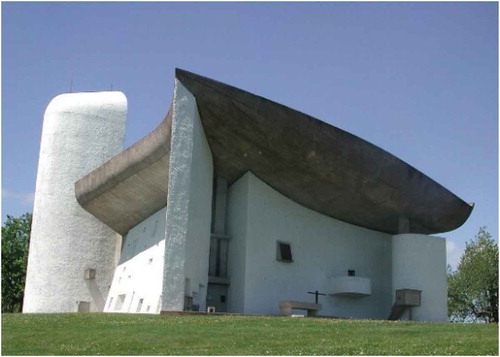
Figure 2. The multi-interpretation of Le Corbusier, Ron champ chapel (Jencks, Citation2011).
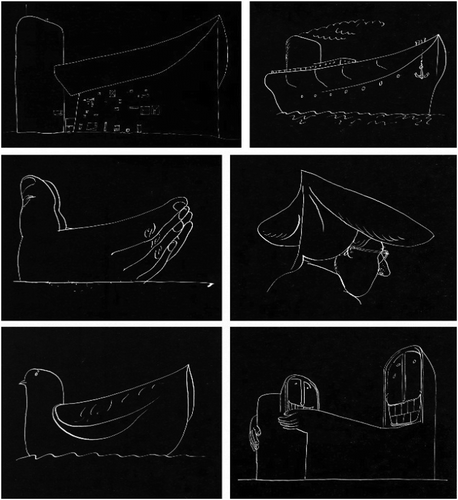
Metaphor—this grammatical statement has the association between the source and the target. Source refers to the thing or object that transfers the message or the impact, and target refers to the recipient of the impact. The target could be a listener or an onlooker. Being related to the target or the listener or the viewer, the metaphor has been explained as open thinking. This type of language style has mostly been considered as a cognitive language whose understanding depends on the mental state of the audience (Lakoff & Turner, Citation1989).
2.2. Conceptual metaphors
Some scientists have stated that metaphors are not necessarily stylistic rather they are cognitively considerable as well. In Metaphors, George Lakoff and Mark Johnson discuss that metaphors are permeating our daily routine life, not just in language but also in thinking and practice. A usual explanation of a metaphor can be defined as a conflict that indicates how two things that are not similar in most aspects are the same in other considerable aspects. They show how a metaphor is directly understanding and comprehending one specific type of thing regarding another one. The author’s name this concept a “conduit metaphor.” According to the meaning, they implied that a speaker could set ideas or objects into words or containers and then transfer them through a channel or passageway to a listener who gains that idea or object out of the container and makes meaning of it. In other words, the relationship is something that the thought goes into. The container is distinct from the thoughts themselves. Lakoff and Johnson take various examples of daily routine metaphors we use, such as “argument is war” and “time is money.” Metaphors are greatly utilized in context to define personal thoughts. The authors of the present research also indicated that relationship can be considered as a machine: “the relationship is not what one does with the machine, but is the machine itself” (Lakoff & Johnson, Citation2011).
2.3. Metaphors used in architecture and urbanism
When we utilize the linguistic metaphor metaphorically, in fact, we can say that a linguistic metaphor is similar to an architectural metaphor. This shows how we can comprehend the reasons for the fact that metaphor is a main factor to the structured environment mainly when “metaphor permits us to comprehend a comparatively intangible or inherently unbuilt subject matter in terms of a more tangible or at least more highly built subject matter” (Lakoff, Citation1992). Specifically, in England during the twentieth century, metaphors originated from some arts same as sculpture and painting served to contradict the emerging expertise of the architecture and failing to keep its “artistic” position. The utilization of metaphors, which are themselves unfixed and transforming, shows the very unfixed and transforming essence of these approaches. Metaphors also allow to comprehend the operation and instruments architecture and urban development position in their very strange connection between theory and practice, matter and thought references and outside contexts (Gerber & Patterson, Citation2013). Architecture that is considered as a model of visual art and relations also bring the visual language of relationships. Architecture as an element of visual language includes grammatical structure and is transferring its impacts of messages. Architecture as a visual language maintains its own grammatical structure to indicate the mind. Metaphor is changed to one of the strongest Post-Modern Architecture’s tool to indicate the critic and perversion of the modern era. It strongly indicates the defeat of modern architecture and makes fun of the expiration of the modern period (Jencks, Citation1991).
In terms of metaphor and iconology, there are the indirect meanings, the rather unseen references to cosmos and nature. These are made clear in the ecological images but remain understood in other iconic signs. It is this cosmic and nature symbolism which is the main genre that has emerged in 50 years of Post-Modernism from Louis Kahn and Le Corbusier to Herzog & de Meuron at the Bird’s Nest to Saadiyat Island (Figure ). These metaphors may be carried over fine or badly, and to be an outstanding icon, they are now a global convention (Jencks, Citation2011).
Figure 3. Metaphors of nature and the cosmos in architecture. (Top row) Le Corbusier, Ronchamp. (centre row) Rem Koolhaas, Porto. Frank Gehry, Disney. Enric Miralles, Scottish Parliament. Norman Foster, Swiss Re (Jencks, Citation2011).
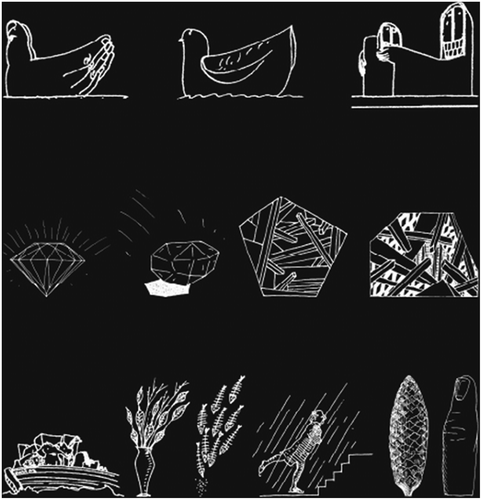
In the case of Norman Fosters Swiss Re skyscraper in London (Figure ), the codes are quite perceptible—cigar, screw, missile, bullet, finger, pinecone, pens—and the somewhat far-fetched—brain and Russian Doll. The outlines that Madelon Vriesendrop and have made to make these analogies mainly map a design or silhouette, and clearly there are much more than the ones we indicate: mainly, visual metaphors in the details, materials and interior spaces (See Figure ).
Figure 4. Norman Foster, Swiss Re Headquarters, London 2000–2004 (Jencks, Citation2005).
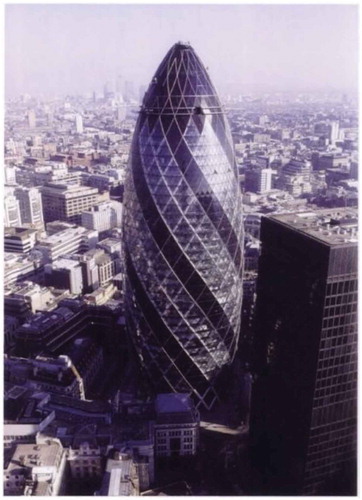
Figure 5. Metaphorical analysis of a few Comparison drawings by Madelon Vriesondrop (Jencks, Citation2005).
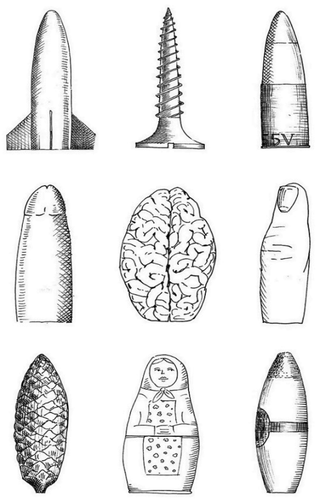
All these resemblances make up the mixed experience of connecting the new and unusual figure to the old and unknown code. That relating action is what the eye and brain perform when encountered by a surprisingly non-identical structure. They map new codes onto the old visual codes. This immediate and largely senseless process leads to the emergence of metaphor in Fosters Skyscraper, the abstract one, “it looks like a gherkin” and public and journalistic initiation. Further, that feedback creates the iconic structure, the architecture in the form of something strange, attracting, fearful and glamorous (Jencks, Citation2005).
2.4. New exterior addition
Robert Venturi focused on the significance of the structure in transferring a message to the public. Venturi states that the physical figure of a structure could be perceived in many aspects, and each perception is more or less true for its instant because all the architecture works have many aspects and levels of meaning (ŽIžEk, Citation2011). The transformation process of intangible aspects into physical is being named as the process of “Metaphoric Process.” The most successful metaphoric process is perhaps Notre Dame du Haute—Ron champ Chapel of Le Corbusier, which initiates the idea of a crab but could be perceived as many other things by its audiences (Ricoeur, Citation1978). Mostly, the metaphor is not definitely identical but is understood as the rationale, organized and comprehensive; “Architecture is ordinary but endangers activity. It is sometimes considered that, because everyone does it, the design does not need careful investigation. Design, in fact, is permeating in routine life. The design is mostly inherent as we try to manage and amend a situation” (Barringten & Hart, Citation2012). A new external addition to a historic structure should be considered in a restoration project only after defining that the requirements for the new or adjusting function cannot be successfully followed by changing non-defined interior spaces. If the new function cannot be supported in this manner, then an external additive may be an appropriate alternative. Restoration as a method is determined as the action or process of making an adjusted function possible for a property through restoration, changing and additions while preserving those portions or specifications which bear its historical, cultural or architectural significance (Guzmán-Torres, Citation2009). New additions have been studied by historical specialties within a social and political frame by architects and architectural historians regarding the various techniques and styles of the construction process and by urban planners as successful or unsuccessful contextual planning. Although within the historic preservation processes and rehabilitation practices of the National Park Service, the main aim of new additions is to ensure that they preserve the characteristics of historical structures (Weeks, Citation1998).
An addition should be planned to be adjusted with the historical character of the structure and, therefore, follow the Standards for Rehabilitation. Standards 9 and 10 apply mainly to new additions: “New additions, external alterations, or affiliated new construction shall not lead to the destruction of historical materials that is the characteristics of a property. The new works and actions should be distinct from the old ones and should be adjusted with the massing, size, scale, and architectural specifications to maintain the historical virtue of the property and its surrounding” (Morton, Hume, & Weeks, Citation1987). New additions and adjacent or affiliated new structures should be considered in such a manner that, if eliminated in the future, the requisite form and principles of the historic property and its environment would be safe. The issue of new additions is important because a new addition to a historical structure has the potential to transform its historic characteristics to impair and destroy important historical materials and attributes. A new addition also has the potential to muddle the public and to make it difficult or unachievable to distinct the old ones from the new ones or to realize which part of the historical structure is originally historic (Weeks, Citation1986). An addition may be an appropriate development for a historical building. It can strengthen the constant function of a property and indicate its changing functions (Winter, Citation2002).
2.5. Compatible new additions to historic buildings
There are no principles or instruction to design a new addition that follows the standards. A new addition to a historical structure that follows the standards can be any architectural style, traditional, contemporary or a simpler version of the historical structure. Although there must be a steadiness among differentiation and compatibility to keep the historical characteristics and the identity of the structure being developed. New additions that closely duplicate the required structure or are in severe contrast to it decrease this balance. Inherent in all of the guidance is the concept that an addition needs to be subordinate to the historic building.
A new addition must conserve main historical materials, specifications and forms, and it must be adjusted but distinct from the historical structure. For this aim, it is required to exactly consider the position or place of the new addition, its size and scale, and massing when designing a new addition. To maintain a property’s historical characteristics, a new addition should be visually perceptible from the historical structures. This does not refer to the fact that the addition and historic structure must be obviously contrastive regarding the design, material and other visual factors. Rather, the new addition must take its design hints from but not make a copy of the historic structure (Weeks, Citation1986). Too much focus on visual factors leads to disproving the opportunity of evocation and creativity.
Most successful groups of structures have artificially various styles and materials. It is specified that there are three main approaches that have the constant need to initiate harmony with the current settings. Therefore, each of these three main approaches shows a distinct design philosophy (Carmona, Heath, Oc, & Tiesdell, Citation2003). Because a new external addition to a historical structure can destroy or damage the main materials and can lead to transforming the building’s characteristics, an addition must be considered only after it has been defined that the new function cannot be fulfilled by changing any distinct, or minor, interior spaces. If the new function cannot be fulfilled in this manner, then an attached addition could be a reasonable alternative if designed carefully. A new addition should be applied in a manner that maintains important materials and attributes and maintains the historical characteristics of the building. At last, an addition must be distinct from the historical structure in a way that the new works are not mistaken with what is genuinely part of the old building (Weeks, Citation1986).
2.6. Metaphoric aspects of addition
The reasoning is done in the two main stages and through the logical combination of the two examples; the third point is investigated and provided the reasoning for the research question of the present study. In the first stage, the influence of metaphorical dimensions of a structure on the exactness of the mental image of users of it is examined.
In the second step the relation between the annex and the old structure is defined as the analyses of stability, and finally, through this perceptual relation, it is indicated that the metaphoric dimensions of the annex influence the mental image of the original historic structure.
2.7. High school crinkled wall/Wiesflecker architecture
This high school is built at Austria (Kufstein city) is a construction with a long history. It has been designed by architecture specialties Willy Graf from Stuttgart and founded in 1907. Around 1980 followed a restoration and renovation process, seamlessly integrated into the similar style of the current construction. Thirty years later, in 2009, for the required extension, an architectural competition was achieved by Johannes Wiesflecker, who planned a project that was persuading both in its urbanism method to the already existing original building structure and its special interior organization (Figure ).
Figure 6. (High school crinkled wall designed by Wiesflecker) (Caballero et al., Citation2016, www.archdaily.com).
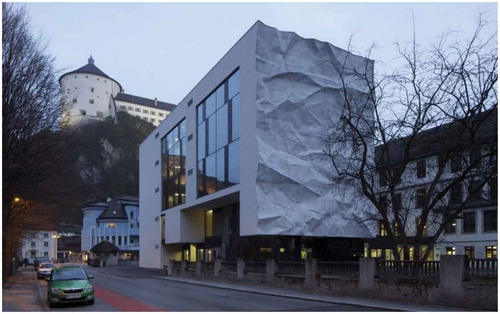
Set clearly distinct from the current structure, an explicit historic building in the local historical style of the beginning of twentieth century, he set a new independent structure, in which now approximately half of the original groups are accommodated. A kindly designed entry area develops under the new structure up to the u-formed current structure organized around an interior courtyard and creates together with the newly planned gymnasium area in the basement floor, a pleasing spatial course.
The completely plain facade of this building is “interrupted” by a folded wall (a spatial concrete building), completely changing it from an insensitive, low-quality building into a very motivated building. This strange school extension including a folded wall was planned thoroughly by Wiesflecker architecture, with the help of Austrian artist, Karl-Heinz Klopf (Table ). Analysis of compatibility of high school crinkled wall was reported by Soosani (Citation2013). The wall is a metaphor for the next generation and indicates the academic development and the acute process of examining ideas. Just like when you write down on paper an idea and then you all of a sudden recognize that something even better occurs to your mind. You crush the paper and throw it away and you are now willing to start again. The new attractive addition opposes with the well-ordered and effortless straightforward façade and relates the original school, constructed in 1907, with the surrounding environment. The compatibility of this building will be examined below in regards to the designing criteria.
Table 1. Analysis of compatibility of high school crinkled wall
This high school façade is made of concrete and glass. It is in conformity with its context because of using appropriate materials and colors with context. Moreover, the balance and vertical and horizontal focus of the fences in the façade is similar to the existing constructions in the context. According to the sitting factors, it matches the current frameworks and block sizes, but it is in extent with its surrounding. This building also relates to the neighbor structure’s height and reverse sides. In addition, the entry side of the structure is set from the similar direction to other structures. Regarding this examination, most factors are well suited to the context and its planning approach established as the “constant” method (Table ).
2.8. Glasgow women’s library
The library of Glasgow women is considered as a horizontal annex and a library for the public, registered company and charity organization in Glasgow, Scotland. Glasgow women’s library is a vivid information center housing an imported library, archive collections and contemporary and traditional artworks affiliated with women’s lives, traditions and developments (Figure ).
Figure 7. Glasgow women’s library. (www.dezeen.com).
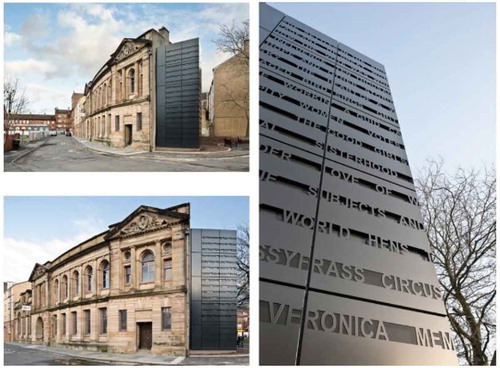
The subject of significant works of old studies is imprinted onto the walls of this development to a sandstone library in Glasgow, which has been renovated to initiate a center for women’s traditions. The Glasgow women’s library is the UK’s only ascribed museum defined to women’s history and includes an imparted library, archive collections and contemporary and historical artworks affiliated to women’s lives, histories and achievements. The renovation process pointed to fulfilling the spatial and access circumstances of its new residences, as well as disclosing some of the original characteristics of the interior design. On the exterior side, renovation of the complicated stone carvings, decorative fence detailing and inscribed writings is being considered.
According to the pattern on the façade, this structure is not fulfilling the same pattern with neighboring structures. In addition, the structure does not relate to the current pattern size and the entry side of the structure is tested from a different direction. Moreover, it relates to the other structures’ reverse sides. The planner utilizes various building materials, such as metal, which creates some distinctions in comparison to the color of the structure with its neighboring structures. Glasgow women library is not in conformity with the whole context regarding the proportion, and its volumeis not similar to the other structures in this context. Regarding this analysis, most factors are seen adjusted with the context and its designing method determined as “Contrast and/or Contextual Juxtaposition” principle. The well inscribed by the words (three-dimensional words) completely changing it from an indifferent, low-quality building into a very effective building (Table ). The facade is considered as a metaphor for the library and indicates that this building is a place to maintain books and studying; therefore, metaphorical dimensions of this structure influence the exactness of the mental image of the users.
Table 2. Analysis of compatibility of Glasgow women’s library
2.9. Conclusion
According to the findings in comparison of two existing examples in this review and also the information available in different resources, it can be concluded that:
The metaphor is considered as the transfiguration operation from the abstracts into the visual figure or material figures. One of the main levels of metaphor is referred to the analogy. The main concept in the analogy is practiced to design without any deviation. Further, the metaphor is considered as an element of semiotics, or in other words, the system of signs that includes symbols and signs and the sign stands for the connotative and denotative concepts in the linguistics discussions into architecture. The semiotic system is formed by three main elements as the signified, signified and signifier.
Metaphor as an architecture media is considerably connected to the local context and local perceptions. As a theory, metaphor should be understood as a comprehensive global concept. In fact, the function of metaphor is not an unknown concept in architecture studies. It has been applied by ancient architects as a grammatical media in symbols and signs to indicate the concepts of the symbols and signs, mainly for mental and spiritual constructions. As justification of this study proves the effect of metaphorical aspects of an annex on the user’s mental image of the original building, the outcome of this investigation shows the importance of focus on the metaphoric aspect in the design process of the annex. In this way, the essential meanings of the original historic buildings can be revived with the support of annex. To summarize, through the metaphoric medium, annexes can improve the sharpness of the mental image in users.
Additional information
Funding
Notes on contributors
Mitra Allahmoradi
My name is Mitra Allahmoradi, I have a master and bachelor degree in Architecture from University of Hamedan in Iran. Currently, I am a Ph.D. candidate at the Eastern Mediterranean University in North Cyprus. I always had an interest and passion for Architecture, and therefore, it is not surprising that my research activities are in this field. I have participated in many conferences and published papers on their book collections about identity in architecture, symbolism and metaphor in architecture, morphology, social interactions, cognition and cognitive approach in urban design and architecture. I have written some other papers related to this topic; such as role of symbolism in contemporary extensions to historical buildings. I found this topic interesting and it will relate to the wider issues of psychological, philosophical and semantics discussions.
References
- Antoniades, A. C. (1991). Poetics of architecture: Theory of design . New York: Van Nostrand Reinhold.
- Barringten, B. , & Hart, E. (2012). Architecture: The making of metaphors . Newcastle upon Tyne, UK: Cambridge Scholars Publishing.
- Caballero, P. , Tapia, D. , Sagredo, R. , Yuekang, S. , Overstreet, K. , Comberg, E. , & Bills, Emily . (2016, June). Broadcasting architecture worldwide. Retrieved from https://www.archdaily.com/
- Carmona, M. , Heath, T. , Oc, T. , & Tiesdell, S. (2003). Public place urban space . Britain: Library of Congress Cataloguing.
- Casakin, H. P. (2004). Metaphors in the design studio: Implications for education. In P. Lloyd , N. Roozenburg , C. McMahon , & L. Brodhurst (Eds), Proceedings of 2nd international engineering and product design education conference - The changing face of design education (pp. 265–273). Delft: Nivo Press.
- Casakin, H. P. (2006). Assessing the use of metaphors in the design process. Environment and Planning B: Planning and Design , 33(2), 253–268. doi:10.1068/b3196
- Dezeen Magazine . (n.d.). June 03, 2016. Retrieved from http://www.dezeen.com/
- Gerber, A. , & Patterson, B. (2013). Metaphors in architecture and urbanism: An introduction . Bielefeld: Transcript.
- Jencks, C. (1991). The language of post-modern architecture . New York: Rizzoli.
- Jencks, C. (2005). The iconic building: The power of enigma . London: Frances Lincoln.
- Jencks, C. (2011). The story of post-modernism five decades of the ironic, iconic and critical in architecture . Chichester: J. Wiley & Sons.
- Lakoff, G. (1987). Women, fire and dangerous things: What categories reveal about the mind . Chicago: University of Chicago Press.
- Lakoff, G. (1992). Metaphor: The language of the unconscious. The theory of conceptual metaphor applied to dream analysis. Paper presented at The Association of California at Santa Cruz, CA.
- Lakoff, G. (1993). The contemporary theory of metaphor. In A. Ortony (Ed.), Metaphor and thought (pp. pp. 202–251). New York: Cambridge University Press.
- Lakoff, G. , & Johnson, M. (2011). Metaphors we live by . Chicago, Ill: Univ. of Chicago Press.
- Lakoff, G. , & Turner, M. (1989). More than cool reason: A field guide to poetic metaphor . Chicago: University of Chicago Press.
- Mohamed, A. S. (2017). Smart materials innovative technologies in architecture; towards innovative design paradigm. Energy Procedia , 115, 139–154. doi:10.1016/j.egypro.2017.05.014
- Morton, W. B. , Hume, G. L. , & Weeks, K. D. (1987). The secretary of the interiors standards for rehabilitation and guidelines for rehabilitating historic buildings . Washington, DC: National Park Service Preservation Assistance Division.
- Muller, B. (2004). Metaphor, architectural design, and environmental response . Eugene, United States: University of Oregon.
- Ortony, A. (1991). Metaphor and thought . New York: Cambridge University Press.
- Richards, I. (1965). The philosophy of rhetoric . London: Oxford University Press.
- Ricoeur, P. (1978). The metaphorical process as cognition, imagination, and feeling. Critical Inquiry , 5(1), 143–159. doi:10.1086/447977
- Soosani, L. (2013). Questioning the compatibility of the infill architecture in historic environment, case study: Walled city of Nicosia (Unpublished masters thesis). Famagusta, North Cyprus: Eastern Mediterranean University.
- Torres, Z. N. G. (2009). Historic buildings and contemporary additions: The elements of a cohesive design relationship . A master s Final Project, School of Architecture, U.S.A: University of Maryland. Retrieved June 13, 2010, from http://lib.umd.edu/drum/bistream/1903/9408/1/guzman_DRUM_S09.pdf .
- Ungerer, F. , & Schmid, H. (2013). An introduction to cognitive linguistics . London: Routledge.
- Weeks, K. D. (1986). New exterior additions to historic buildings: Preservation concerns. Washington, D.C: U.S. Department of the Interior, National Park Service, Cultural Resources, Heritage Preservation Services.
- Weeks, K. D. (1998). New exterior additions to historic buildings: Preservation concerns . Washington, D.C.: U.S. Department of the Interior, National Park Service, Cultural Resources, Heritage Preservation Services.
- Weiss, P. (2000). Emphatics . Nashville: Vanderbilt University Press.
- Winter, N. V. (2002). Design guidelines for historic districts in the city of Pasadena, California: With the secretary of the interior’s standards for historic preservation . Pasadena, CA: Winter &.
- ŽIžEk, S. (2011). Living in the End Times . London: Verso.
